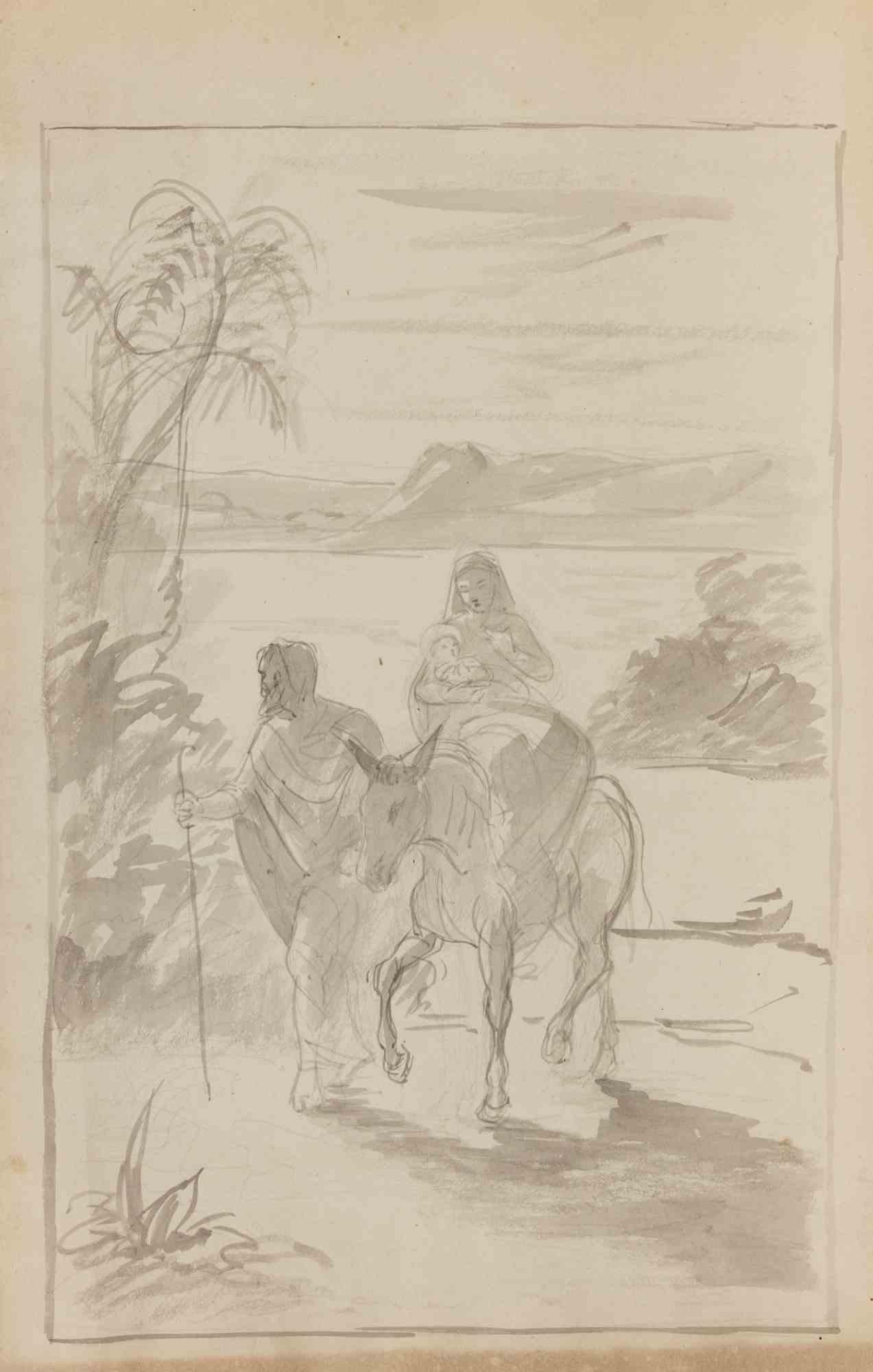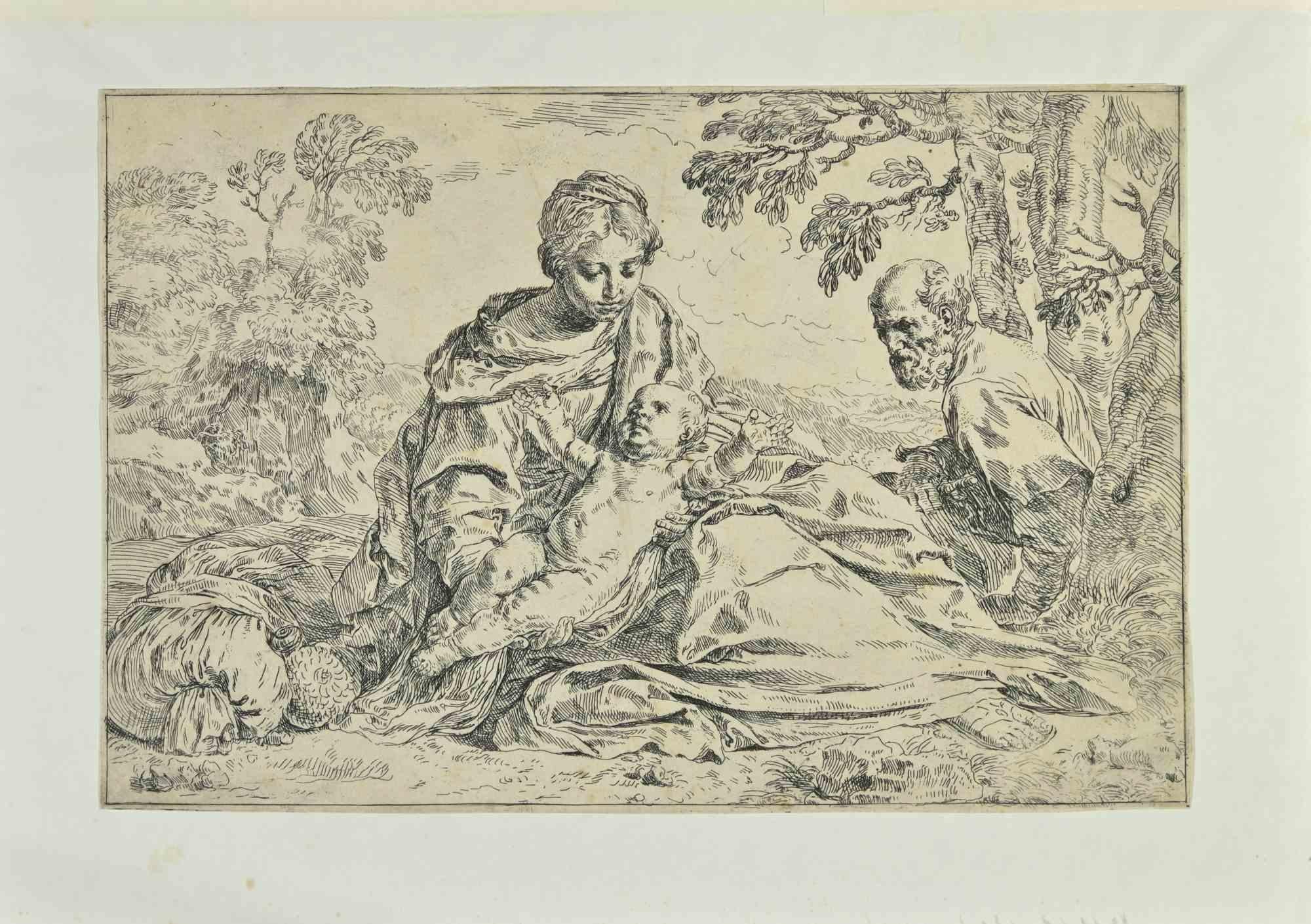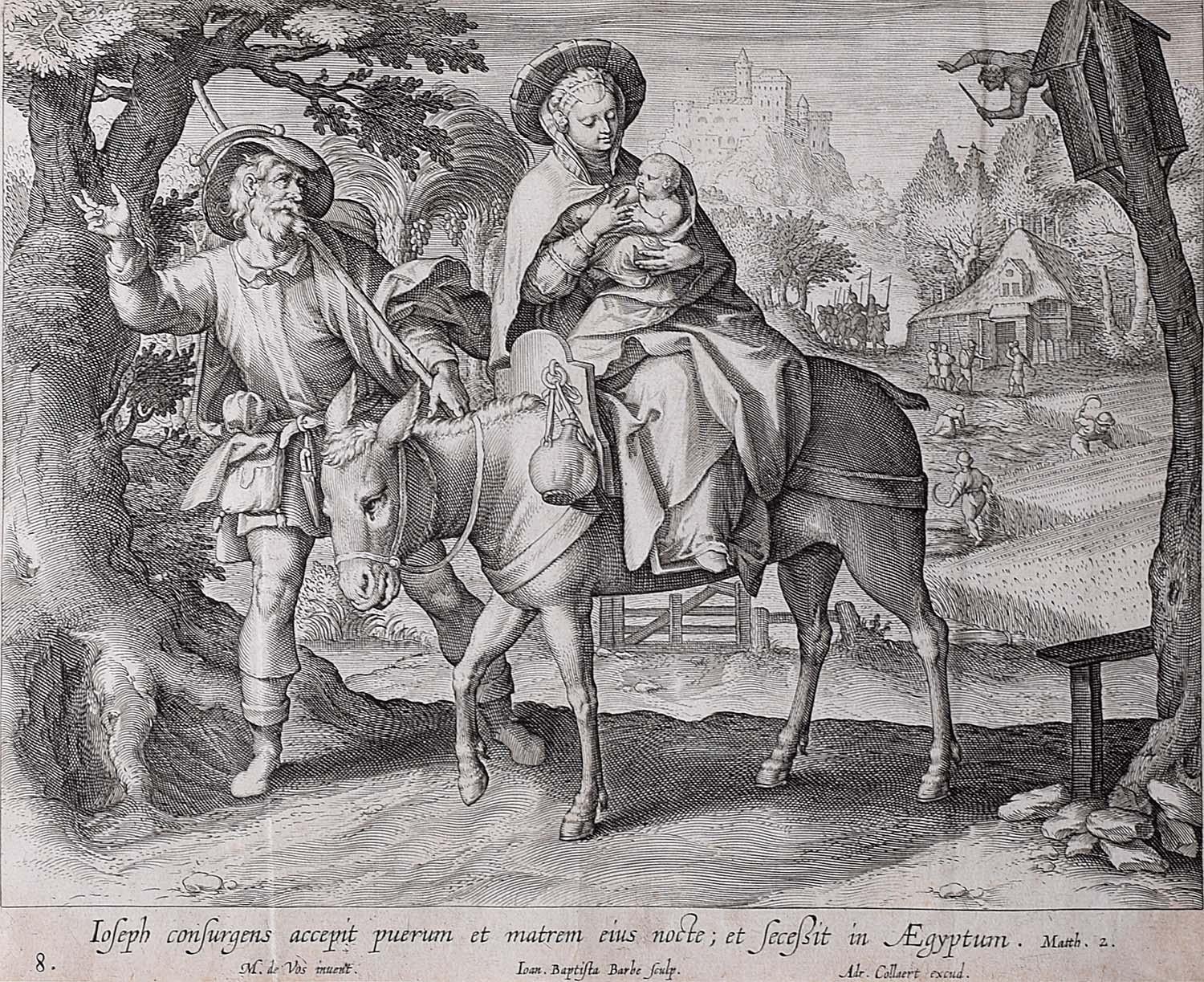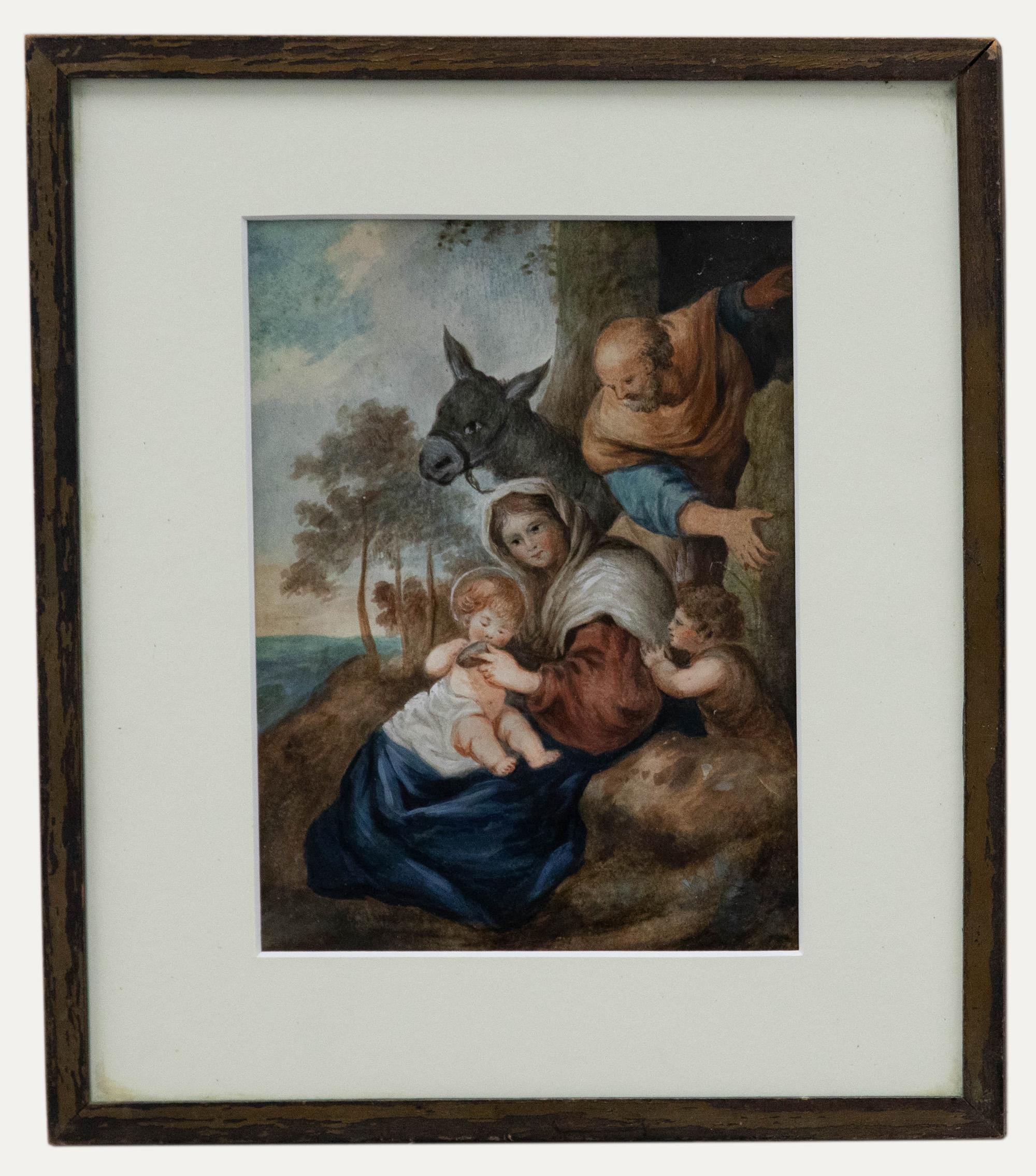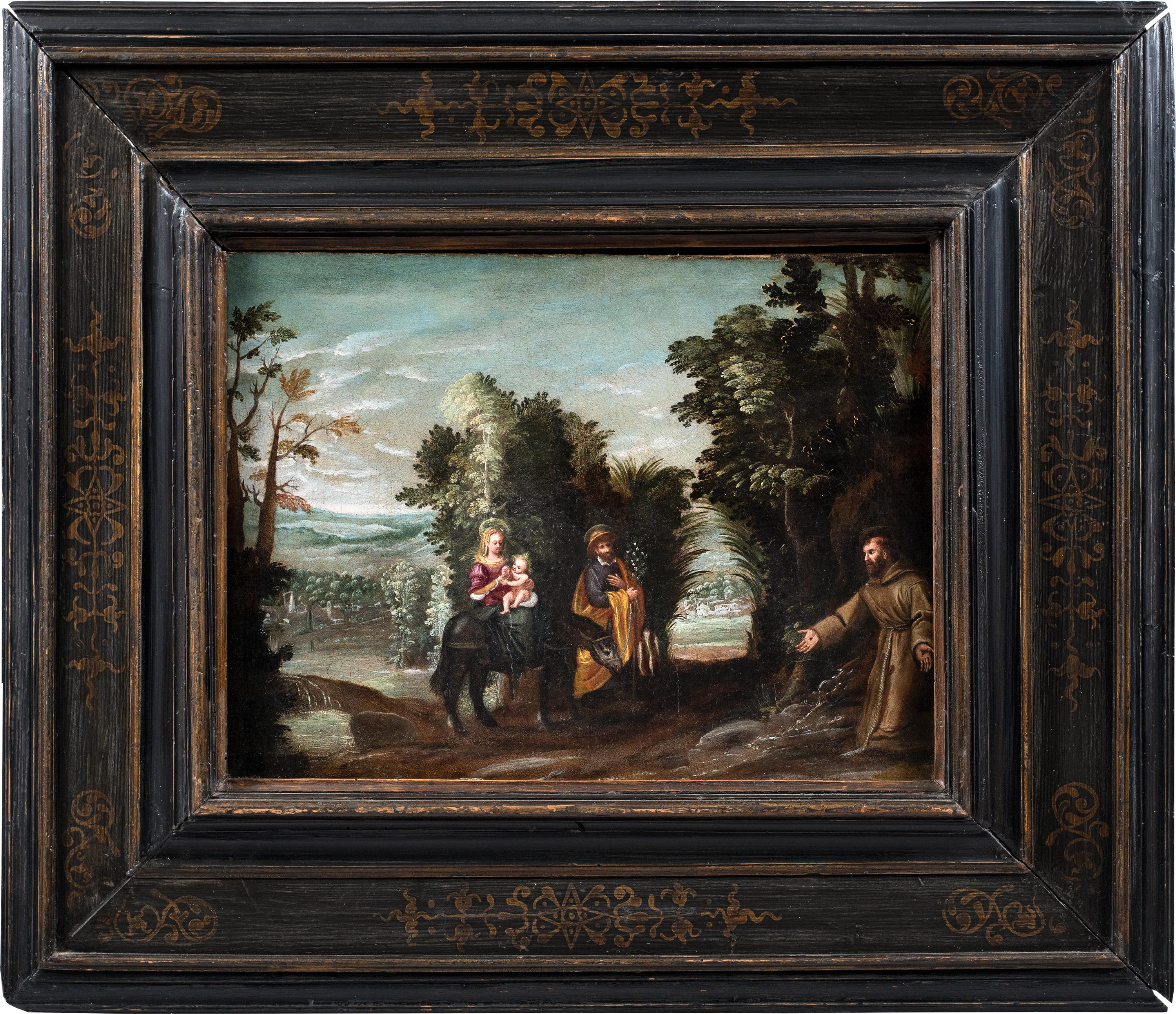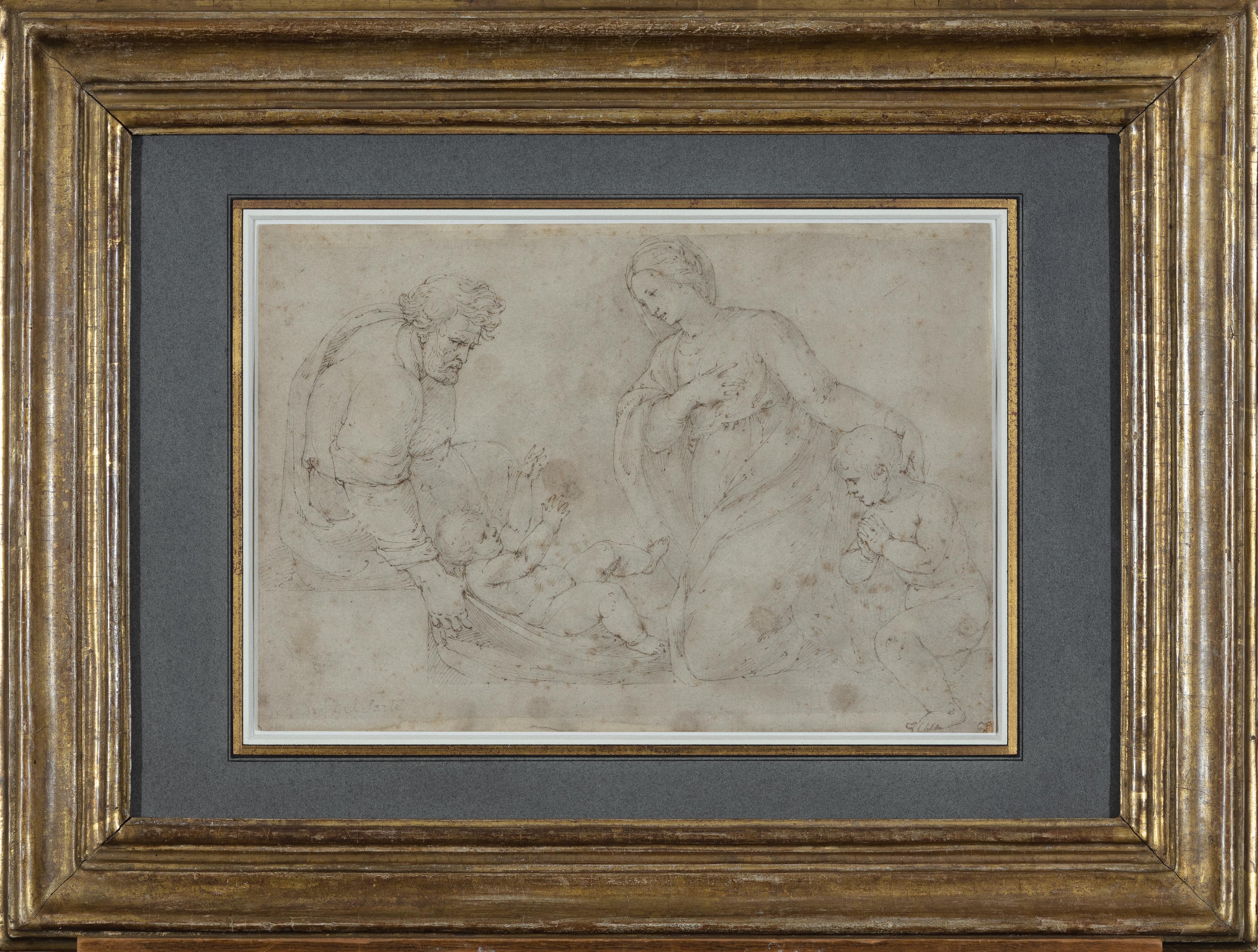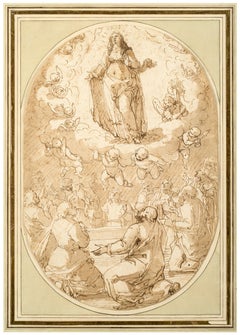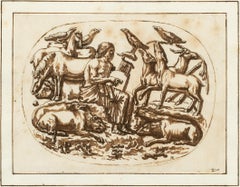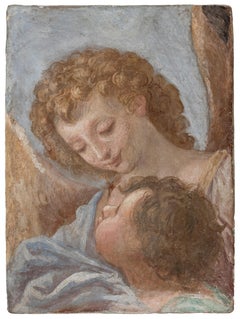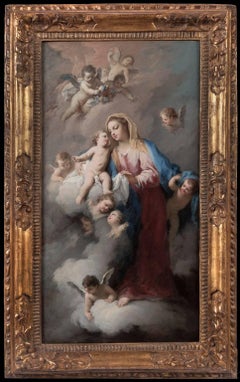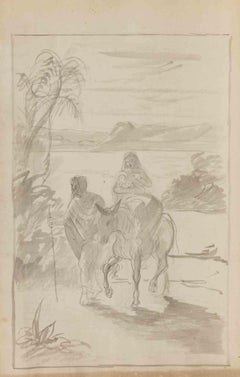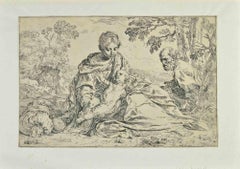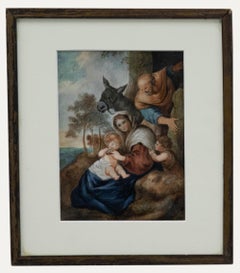Items Similar to The Flight into Egypt
Want more images or videos?
Request additional images or videos from the seller
1 of 5
Luca CambiasoThe Flight into Egypt
$50,000
£37,763.82
€43,643.81
CA$70,132.65
A$77,994.30
CHF 40,826.42
MX$951,435.60
NOK 512,998.80
SEK 482,541.60
DKK 325,772.70
About the Item
Inscribed: 3. una Madonna che va in Egitto, verso, and Madonna che va in Egitto, recto
Provenance:
Private Collection, UK, since 1999
This expressive and boldly executed drawing is the work of Luca Cambiaso, the leading artistic personality in Genoa in the sixteenth century and one of the most dynamic draughtsmen in European art. The drawing dates from the mid-1550s to early 1560s at the height of the artist’s power. At this moment in his career, defined by his “serene style,” Cambiaso’s compositions became more focused and reduced to their essential elements. The mule’s hind quarters dominate the visual field and the outdoor setting is indicated by little more than the tree standing along the left edge of the sheet. The large scale of the drawing and the calligraphic penmanship, which lends a motion and drama to the scene, provide significant visual interest and appeal to the modern eye. Cambiaso’s spontaneous handling fully exploits the dynamics of the quill pen—the lines are vigorous, animated, and possess a great suggestive power. Both vibrant and audacious in its depiction of the Flight into Egypt, this drawing represents an exceptional addition to Cambiaso’s graphic oeuvre.
Cambiaso infuses the otherwise inert biblical narrative with dynamism by placing the figures close to the pictorial plane and orienting them along a steep diagonal, from the upper left to the lower right, giving the appearance that they are about to descend a steep slope and disappear from view. The artist employed a similar vertiginous compositional device in his drawing of the Chariot of the Setting Sun, in which the horses are similarly conceived. More explicitly, and using the same media, Cambiaso’s drawing of Saint Martin and Beggar in the Princeton Art Museum displays a horse almost identically envisaged (Fig. 1). A horse seen from behind with its right rear leg raised was a leitmotif for the artist, with some details, such as the diagonal hatching to indicate the shadow on the underside of the hoof, closely repeated. Regarding the representation of the mule in the present drawing, it is important to note Cambiaso’s acute sensitivity to the subject matter, even when composing with speed. In contrast to his many drawings that include horses with elaborate tack, such as the Saint Martin and the Beggar, our composition shows a plain stirrup and strap across the mule’s hindquarters and its tail is not elaborately plaited. The treatment is in keeping with the theme of poverty that underlies this biblical subject (Matthew 2:13-15). The Holy Family were, after all, refugees, and the fact that Herod was intent on killing the child would appear to explain Joseph’s somewhat anxious glance over his shoulder.
The drawing displays many of the salient characteristics of Cambiaso’s draughtsmanship. In a manner entirely consistent with his working method, he first sketched his preliminary ideas with thin pen lines in a lighter ink over faint traces of black chalk and later confirmed or corrected them with a darker tone of brown. As is typical of the artist, spare hatching suggests the surrounding space and foreground terrain. Half-moon like circlets indicate pebbles in the foreground, with long looping lines defining the leaves of the palm tree, terminating in hooks as the pen shifts from right to left. Typically, limbs, hands, lips, noses and eyelids are slightly geometricized with circlets, triangles, ticks and hooks, and quick flicks of the pen indicate knees, muscles and tendons. The articulation of the Virgin’s hand and the physiognomy of the infant Christ are nearly identical to those in Cambiaso’s Virgin and Child with Putti, formerly in the collection of the Rugby School (Fig. 2). Tellingly, so too is the relationship between mother and child, as the Virgin intimately embraces the infant Christ.
Within the context of Cambiaso’s drawings, the scale and format of this work, the quality of execution, and above all its striking interpretation of the subject suggest that it was conceived as an autonomous work rather than a preparatory study for a painting. Its monumentality, dynamism, and the clarity of narrative appear to connect it with a number of comparably large drawings illustrating the early life of Christ. These include two versions of the Holy Family at Rest preserved in the Rijksmuseum and the First Steps of the Infant Christ in Edinburgh. The early inscription on the verso of this sheet—“3. una Madonna che va in Egitto”—suggests it may have been the third in sequence of a series of subjects drawn on a similar scale in the same technique owned by an early collector. Cambiaso’s only known treatment of the subject in paint is an altarpiece of La Fuga in Egitto that is mentioned in an early guidebook to Genoa as in the church of Santa Maria delle Grazie al Molo outside the city, close to the Porta Lanterna (current location unknown).
- Creator:Luca Cambiaso (1527 - 1585, Italian)
- Dimensions:Height: 14.875 in (37.79 cm)Width: 11.25 in (28.58 cm)
- Medium:
- Movement & Style:
- Period:
- Condition:
- Gallery Location:New York, NY
- Reference Number:1stDibs: LU1029077782
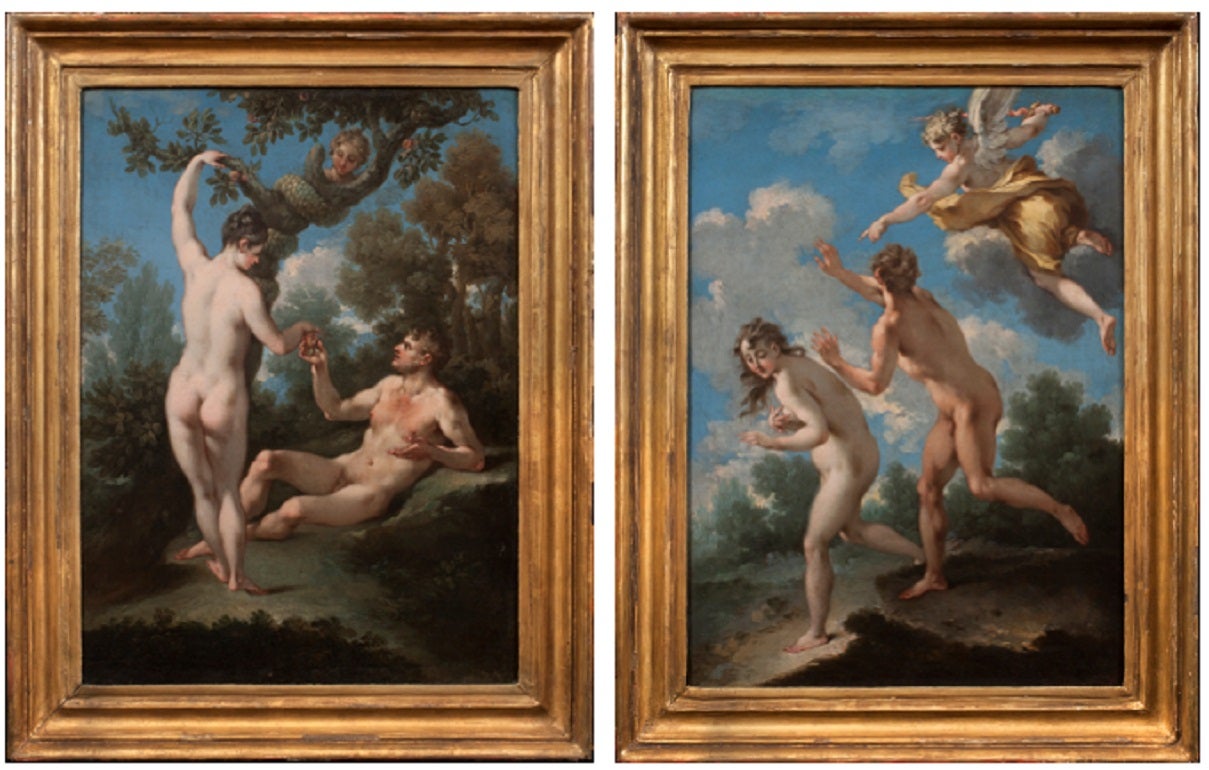
About the Seller
5.0
Recognized Seller
These prestigious sellers are industry leaders and represent the highest echelon for item quality and design.
Established in 1997
1stDibs seller since 2012
22 sales on 1stDibs
Typical response time: 8 hours
- ShippingRetrieving quote...Shipping from: New York, NY
- Return Policy
Authenticity Guarantee
In the unlikely event there’s an issue with an item’s authenticity, contact us within 1 year for a full refund. DetailsMoney-Back Guarantee
If your item is not as described, is damaged in transit, or does not arrive, contact us within 7 days for a full refund. Details24-Hour Cancellation
You have a 24-hour grace period in which to reconsider your purchase, with no questions asked.Vetted Professional Sellers
Our world-class sellers must adhere to strict standards for service and quality, maintaining the integrity of our listings.Price-Match Guarantee
If you find that a seller listed the same item for a lower price elsewhere, we’ll match it.Trusted Global Delivery
Our best-in-class carrier network provides specialized shipping options worldwide, including custom delivery.More From This Seller
View AllThe Assumption of the Virgin
Located in New York, NY
Provenance:
Unidentified collector’s mark “D.G.R,” lower right (Lugt 757b)
Wilhelm Suida (1877–1959), New York; by descent to:
Robert L. and Bertina Suida Manning, New York, until 1996
Private Collection, USA
This impressive drawing of the Assumption of the Virgin is the work of the Genoese artist Giovanni Battista Paggi. The son of a nobleman, Paggi received a humanist education and was a self-taught artist. According to Paggi’s first biographer, Raffaele Soprani, it was only after encountering Luca...
Category
16th Century Old Masters Figurative Drawings and Watercolors
Materials
Paper, Ink, Pen
Orpheus and the Animals, A Study after an Ancient Bas-Relief
Located in New York, NY
Inscribed “55” and “218” in the lower right
Watermark: Heawood 1351
Laid down on historic Cassiano Del Pozzo mount
(Mount Type A, 531 x 402 mm)
Provenance:
Commissioned by Cassiano dal Pozzo (1588–1637) for his Museo Cartaceo (Paper Museum) and kept in the library of his palazzo, via dei Chiavari, Rome
Transferred with the entire dal Pozzo collection by fidecommesso to his younger brother, Carlo Antonio dal Pozzo (1606–1689); by descent to his second son:
Gabriele dal Pozzo (d. 1695); by descent to his wife:
Anna Teresa Benzoni and after her remarriage in 1697, the Marchesa Lancellotti de’ Ginnetti (d. 1736); by descent to their son:
Cosimo Antonio dal Pozzo (d. 1740); by whom sold with the Dal Pozzo library in 1703 to:
Pope Clement XI for the Vatican Library; by whom transferred as part of the Museo Cartaceo in January 1714 to his nephew:
Cardinal Alessandro Albani (1692–1779), Palazzo ‘alle Quattro Fontane’ in Rome; by whom sold in 1762 to:
James Adam, agent for the British Royal Librarian Richard Dalton (1715–1791)
King George III of England, Buckingham House
Among the sheets of the ‘Museo Cartaceo’ appropriated by Richard Dalton during a reorganization of the drawings, circa 1786-1788; his estate sale, Greenwood’s, London, 11-19 May 1791; where acquired by:
John MacGowan...
Category
16th Century Baroque Figurative Drawings and Watercolors
Materials
Paper, Ink, Pen
A Guardian Angel and a Child
Located in New York, NY
Provenance:
Cornelius Vanderbilt, New York; by whom gifted in 1880 to:
The Metropolitan Museum of Art, New York (80.3.673); deaccessioned and sold:
Christie’s, New York, 12 June 19...
Category
17th Century Old Masters Portrait Paintings
Materials
Terracotta, Gesso
Madonna and Child with Angels in the Clouds
Located in New York, NY
Provenance: Charles H. and Virginia Baldwin, Claremont, Colorado Springs, Colorado ca. 1907-1934; thence by descent until sold in 1949 to:
Charles Blevins Davis, Claremont (renamed Trianon), Colorado Springs 1949 -until gifted in 1952 to:
The Poor Sisters of Saint Francis, Trianon, Colorado Springs, 1952 until acquired, 1960, by:
John W. Metzger, Trianon, renamed as the Trianon School of Fine Arts, Colorado Springs, 1960-1967; when transferred to:
The Metzger Family Foundation, Trianon Art Museum, Denver, 1967 - 2004; thence by descent in the Metzger Family until 2015
Exhibited: Trianon Art Museum, Denver (until 2004)
The present work is a spectacular jewel-like canvas by Amigoni, rich in delicate pastel colors, most likely a modello for an altarpiece either lost or never painted. In it the Madonna stands firmly upon a cloud in the heavens, her Child resting on a delicate veil further supported by a cloud, as he gently wraps his arm around his mother’s neck. From above angels prepare to lower flowers and a wreath, while other angels and seraphim surrounding the two joyfully cavort.
Dr. Annalisa Scarpa, author of the forthcoming monograph on Jacopo Amigoni...
Category
18th Century and Earlier Figurative Paintings
Materials
Canvas, Oil
Three Angels
By Domenico Piola the Elder
Located in New York, NY
Provenance:
Robert L. and Bertina Suida Manning, New York, until 1996
Private Collection, USA
One of the leading artists in Genoa during the second half of the seventeenth century, Domenico Piola came from a successful family of artists, renowned for their many illusionistic ceiling programs throughout Genoese churches and palaces. A prolific draughtsman and painter, Domenico oversaw an extremely productive studio. In addition to his collaborations with numerous other artists, Domenico also provided many designs for book illustrations and prints that circulated throughout Europe, earning him international exposure and high acclaim in his own day.
As Dr. Anna Orlando has indicated (written communication), the present work is an early work by Piola, datable from the late 1640s. At this time the young artist came strongly under the influence of Castiglione and Valerio Castello, while admiring the works of Giulio Cesare Procaccini. Piola’s works from this period are exuberant and fluid, and the artist’s love of portraying children is evident from the angels and putti that populate both his altarpieces and more intimate paintings.
The present work depicts three angels...
Category
17th Century Baroque Figurative Paintings
Materials
Canvas, Oil
Woman in Fantasy Costume (pair)
By Jean Baptist Le Prince
Located in New York, NY
The pair consists of the present work and an engraving after it by the hand of Giles DeMarteau (Liège 1722 – 1776 Paris) titled Woman in Fantasy Costume, after Jean Baptiste Le Prince, and measuring, 10 ⅜ x 8 ⅝ inches (26.5 x 22 cm).
DeMarteau's engraving is inscribed at the bottom:
Le Prince inv. del. / Demarteau sc. / A Paris ches Demarteau Graveur du Roi, rue de la Pelterie à la Cloche...
Category
18th Century Drawings and Watercolor Paintings
Materials
Paper, Chalk, Engraving
You May Also Like
The Flight into Egypt- Drawing - 1930s
Located in Roma, IT
Pencil and watercolor drawing realized b an unknown french artist in the 1930s.
Very good condition.
Category
1930s Modern Figurative Drawings and Watercolors
Materials
Watercolor, Pencil
Rest on the flight into Egypt - Etching by Simome Cantarini - 1640 ca
Located in Roma, IT
Rest on the flight into Egypt is an etching by Simone Cantarini executed around 1640. Cantarini also made a painting with the same subject now at the Louvre Museum.
The dimension...
Category
1640s Old Masters Figurative Prints
Materials
Etching
Adrian Collaert Martin de Vos 17th Century Engraving Flight into Egypt print
By Adriaen Collaert
Located in London, GB
We have the full series of 52 prints (including title page) from Vita Passio et Resurrectio Iesu Christi listed. To find the others scroll down to "More from this Seller" and below i...
Category
17th Century Realist Figurative Prints
Materials
Engraving
19th Century Watercolour - Rest on the flight to Egypt
Located in Corsham, GB
A charming watercolour depiction of the Holy family's flight to Egypt. They stop to rest beneath a tree with an infant St. John the Baptist to the right of the composition. Unsigned....
Category
19th Century Figurative Drawings and Watercolors
Materials
Watercolor
$315 Sale Price
20% Off
Baroque Italian master - 17th century figure painting - The flight into Egypt
Located in Varmo, IT
Italian Master (17th century) - The Flight into Egypt Appears to St. Francis.
37.5 x 51.5 cm unframed, 71 x 83 cm framed.
Oil on canvas, in a carved wooden frame (not signed).
Con...
Category
Late 17th Century Baroque Landscape Paintings
Materials
Canvas, Oil
The Holy Family with the Infant Saint John the Baptist
By Raphael (Raffaello Sanzio da Urbino)
Located in Paris, Île-de-France
STUDIO OF RAFFAELLO SANZIO, called RAPHAEL
(Urbino 1483 – Rome 1520)
Title The Holy Family with the Infant Saint John the Baptist
Medium Pen and brown ink, brown wash, over black ch...
Category
16th Century Old Masters Figurative Drawings and Watercolors
Materials
Ink
More Ways To Browse
Antique Stirrups
Antique Horse Hoof
Horse Stirrups
Old Master Drawing 16th
Quill Pen
Paper Quilling
Flight Into Egypt
Horse Lighter
Antique Horse Tack
Antique Horse Stirrups
Lighter Moon
The Little Beggar
Putti Embracing
Antique Calligraphy Pens
Rest On The Flight Into Egypt
Luca Cambiaso
Germany Landscape Painting
Sculpture Abstract Nature
